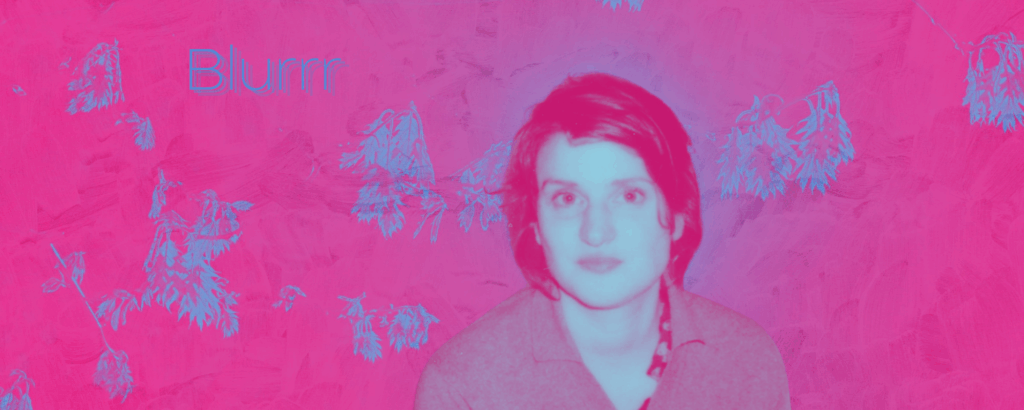Joanne Robertson’s “Blurrr” is the Synesthetic Sublime

Design by Christian Jones
By Christian Jones
A mysterious intimacy has always been Joanne Robertson’s strength—the ability to express a personal history of feeling while shrouding its particular details. Her barely-inteligible warble communicates nuances of emotion that language simply can’t hold.
This is as true of her abstract paintings as her music. They evoke rather than depict. In both mediums, intuition is her North Star. When Robertson paints, she starts with a series of steps: sketching, setting up her studio, and creating a conducive atmosphere with the accompaniment of music. When her ritual is in motion, she then mixes colors on a glass plate and thinks about how color works, how it behaves and what turns her on within it. She listens to color; she paints sounds. Blurrr, is Robertson’s radiant, synesthetic magnum opus. It has a textural richness that conveys the kaleidoscopic inflections of human emotion.
Her brushes: shrill, whispery vocals, reverb, string noise. Her sonic palette: the gentle psithurism of an ancient sun-dappled forest, every shade in the living embers of a dying sunset, distant nebulae glittering unperturbed for millenia, the kind of loneliness that has seeped into your very bones. Production across the album is a kind of spatial chiaroscuro, at times rendering Robertson’s voice clear and defined as on “Last Hay” or “Doubt,” then diffuse as (a) “Ghost.”
Robertson’s earlier releases have the quality of diary entries; they were attempts to sketch the emotions of that specific day or moment. This is true of 2020’s Paintings of Stupid Girls and 2023’s windswept Blue Car, which compiles songs written over a 10 year period. Her style places her among wistful contemporaries: Grouper’s ethereal soundscapes, Jessica Pratt’s mystical twang, early Diane Cluck’s emotional rawness.
Though Robertson’s singer-songwriter delivery has folk overtones, to me, her music has always had an off-kilter naturalism. The tinny, weathered production feels closer to auto-tune than most pristine folk recordings. It’s almost as if it was recorded in an empty concert hall but on a DS, her voice at once spacious and compact. This vaguely folk-tronic quality is more present in Robertson’s collaborations with UK underground producer and musician Dean Blunt, first as an appearance on the 2013 album The Redeemer and on some tracks from the compilation album Roaches 2012-2019. The two went on to co-create three more albums: the 2017 album Wahalla, then 2020’s ZUSHI, and more recently the 2024 album, Backstage Raver. The albums find a unique blend between the two artists—Robertson’s delivery is always emotion over annunciation, pairing well with Blunt’s moody experimental drone-pop. Their collaborations are much closer to some of the central acts of this too-broadly defined “cloud rock”: drawing comparisons to Bar Italia’s shoegazey post-punk and The Crying Nudes’ alluring haze-pop. Robertson’s solo style probably best comes through on “Pusher” and “OFELIA,” where Blunt’s strumming is but a lighter touch against her breathy croon.
The only song reminiscent of these collaborations is the spare “Exit Vendor” — tinged with that familiar Blunt-esque disaffection — “Sweetest vision/ Where are you gonna leave me?” She otherwise ventures new realms. On “Ghost,” her voice echoes as if in a cathedral, distant and diffuse, reverberating as she articulates new phrases that layer the sound ad infinitum. Riffs roll out of her smooth as a river on “Why Me,” trailing over the occasionally clipped guitar strums to create textural depth. Robertson sings “Outside in the rain, through the window in your mind” with a twang that melds the tender inflections of Adrianne Lenker and the hazy swansongs of Mazzy Star. “Doubt” is full of tension and resolve, showing off Robertson’s ability to faithfully portray the subtlest changes in mood.
Her songs with the cellist and composer Oliver Coates move with the heft of changing seasons. Melodies bloom and wither; landscapes and scenes flicker. The transition to “Always Were,” is speckled in light — her guitar twinkles like bells over Oliver Coates’ gentle undercurrent. That placid horizon swells into the grandeur of a sunrise seen from a satellite. The sound is monumental and engulfing — nearly as orchestral in its sense of gravity as “Movement 6” by Floating Points and Pharaoh Sanders.
Another stand out, “Peaceful,” is an interlude that reflects its namesake like the serenity of Nirvana itself — guitar patterns ripple over each other in golden bliss. “Gown” returns to an orchestral arrangement that is full of a sense of urgency, reminiscent of Nick Drake’s “River Man.” Delicate trills show life on the brink of decay: leaves flickering at the edge of their stems, rattling in Coates’ gusts of wind that erupt suddenly over the propulsive landscape. But like the Water Moon Guanyin, who stares at the reflection of the moon in a pool of water as a reminder that all phenomena are illusory, Robertson transforms this act of witness into something cathartic, chanting “Like a peace offering/ The old stars gleam bright (beam bright, beam).” That cosmic empathy is coincidentally what this album feels like. To borrow from Ocean Vuong: “remember, loneliness is still time spent with the world.”
